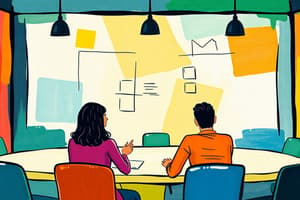Podcast
Questions and Answers
What was the outcome of the members' absence from the meeting?
What was the outcome of the members' absence from the meeting?
- The meeting continued without interruption.
- The key agenda items were not discussed.
- The key agenda items were rescheduled. (correct)
- The meeting was canceled.
Why were the key agenda items rescheduled?
Why were the key agenda items rescheduled?
- To accommodate the absent members. (correct)
- Due to a change in the meeting's objective.
- To give more time for preparation.
- Because the necessary resources were not available.
What was the primary concern during the meeting?
What was the primary concern during the meeting?
- The time allocated for the meeting.
- The impact of the absent members on the meeting. (correct)
- The importance of discussing the key agenda items.
- The availability of resources for the meeting.
What is implied about the meeting's agenda?
What is implied about the meeting's agenda?
What can be inferred about the meeting's organizers?
What can be inferred about the meeting's organizers?
What type of sessions will be offered at several sites?
What type of sessions will be offered at several sites?
What is the primary focus of the training sessions?
What is the primary focus of the training sessions?
Where will the training sessions be held?
Where will the training sessions be held?
What will participants learn about the equipment during the training sessions?
What will participants learn about the equipment during the training sessions?
Why are the training sessions being offered?
Why are the training sessions being offered?
What is the main reason for considering other options?
What is the main reason for considering other options?
What should be done before committing to purchase the 125-H?
What should be done before committing to purchase the 125-H?
What is the primary concern regarding the 125-H?
What is the primary concern regarding the 125-H?
What is the consequence of not considering other options?
What is the consequence of not considering other options?
What is the author's tone towards the 125-H?
What is the author's tone towards the 125-H?
What was the effect of several members being absent from the meeting?
What was the effect of several members being absent from the meeting?
What would have happened if the key agenda items were not rescheduled?
What would have happened if the key agenda items were not rescheduled?
What is the tone of the sentence describing the absence of several members from the meeting?
What is the tone of the sentence describing the absence of several members from the meeting?
What is the purpose of mentioning the absence of several members from the meeting?
What is the purpose of mentioning the absence of several members from the meeting?
What does the sentence imply about the importance of the key agenda items?
What does the sentence imply about the importance of the key agenda items?
What is the purpose of using graphics when communicating with technicians?
What is the purpose of using graphics when communicating with technicians?
What should you consider when communicating with an audience of mixed expertise?
What should you consider when communicating with an audience of mixed expertise?
What is a key characteristic of effective technical writing?
What is a key characteristic of effective technical writing?
Why is it important to define technical terms when communicating with a general audience?
Why is it important to define technical terms when communicating with a general audience?
What is the primary focus of communication with executives?
What is the primary focus of communication with executives?
What is the purpose of asking yourself questions about your audience?
What is the purpose of asking yourself questions about your audience?
What is a common pitfall to avoid in technical writing?
What is a common pitfall to avoid in technical writing?
Why is it important to consider the level of detail when communicating with different audiences?
Why is it important to consider the level of detail when communicating with different audiences?
Flashcards are hidden until you start studying
Study Notes
Effective Technical Communication
- The absence of key members during a meeting can lead to rescheduling of agenda items, highlighting the importance of considering alternative options before making a purchase.
Clarity in Communication
- Careless punctuation can lead to confusion, and clarity is essential in communication.
- Examples of clarity include separating clauses with commas and using correct punctuation marks.
Avoiding Redundancy
- Using redundant words or phrases can lead to confusion and reduce the effectiveness of communication.
- Examples of redundancy include using "alternative choices" instead of "alternatives", "actual experience" instead of "experience", and "completely eliminate" instead of "eliminate".
Considering the Audience
- Technical communication should be tailored to the target audience, including general audiences, technicians, experts, and executives.
- Each audience requires a unique approach, including defining technical terms for general audiences, focusing on construction and installation for technicians, and evaluating design and technology for experts.
Understanding the Reader
- Consider the needs, interests, and level of expertise of the reader when communicating technical information.
- The reader's possible reaction should also be considered when conveying technical information.
Bridging the Gap
- Effective technical communication requires bridging the gap between the communicator's knowledge and the reader's understanding.
- This involves considering the reader's level of expertise, ability, and interest in the technical information being communicated.
Characteristics of Effective Technical Style
- Objectivity, precision, clarity, economy, and audience focus are essential characteristics of effective technical communication.
- Avoid negative connotations, abstract language, and vagueness, and instead opt for clear, concise, and logical material.
Checklist for Effective Technical Style
- Use the characteristics of effective technical style to create a checklist for evaluating technical communication, including objectivity, precision, clarity, economy, and audience focus.
Studying That Suits You
Use AI to generate personalized quizzes and flashcards to suit your learning preferences.




